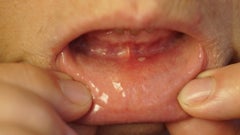
ampicillin
Ampicillin is a penicillin antibiotic. It's approved to treat certain types of bacterial infections, including strep throat or urinary traction infections, in adults and children. But ampicillin might not be a first-choice antibiotic for these infections because of antibiotic resistance. Ampicillin is available as a capsule that's taken by mouth 4 times per day. Some of the more common side effects of this medication include nausea and diarrhea.

Get your GoodRx coupon

What is Ampicillin?
What is Ampicillin used for?
Certain types of bacterial infections, including:
How Ampicillin works
Ampicillin is a penicillin antibiotic. It kills bacteria by preventing them from making their protective covering.
Drug Facts

What are the side effects of Ampicillin?
Common Side Effects
- Diarrhea
- Nausea
- Vomiting
- Rash
Other Side Effects
- Sore mouth or tongue
Serious Side Effects
- Serious allergic and skin reactions: hives, rash, blisters, skin reddening, blisters, swelling of the lips or tongue, difficulty breathing
- Infectious diarrhea: rapid heart rate, foul-smelling diarrhea, fever, nausea, frequent bowel movements (even up to 15 times per day)
Source: DailyMed
The following side effects have also been reported
Along with its needed effects, a medicine may cause some unwanted effects. Although not all of these side effects may occur, if they do occur they may need medical attention.
Stop taking this medicine and get emergency help immediately if any of the following effects occur:
Less common
Fast or irregular breathing
joint pain
lightheadedness or fainting (sudden)
puffiness or swelling around the face
red, scaly skin
shortness of breath
Check with your doctor immediately if any of the following side effects occur:
Rare
Abdominal or stomach cramps and pain (severe)
abdominal tenderness
convulsions (seizures)
decreased amount of urine
diarrhea (watery and severe), which may also be bloody
mental depression
pain at place of injection
sore throat and fever
unusual bleeding or bruising
yellow eyes or skin
Rare
For penicillin G procaine only
Agitation or combativeness
confusion
fear of impending death
feeling, hearing, or seeing things that are not real
Some side effects may occur that usually do not need medical attention. These side effects may go away during treatment as your body adjusts to the medicine. Also, your health care professional may be able to tell you about ways to prevent or reduce some of these side effects. Check with your health care professional if any of the following side effects continue or are bothersome or if you have any questions about them:
Other side effects not listed may also occur in some patients. If you notice any other effects, check with your healthcare professional.
Call your doctor for medical advice about side effects. You may report side effects to the FDA at 1-800-FDA-1088.

Pros and cons of Ampicillin

Cons
Needs to be taken 4 times a day
Not available as a liquid for people who have trouble swallowing the capsules

Pharmacist tips for Ampicillin

Take ampicillin on an empty stomach and a full glass of water, 30 minutes before or 2 hours after meals. Your body absorbs less ampicillin when you take it with food or right after a meal, which means the medication is less effective (doesn't work as well).
Swallow the ampicillin capsules whole. If you're having trouble swallowing them, ask your prescriber about switching you to another antibiotic.
Take ampicillin exactly as prescribed. Make sure to finish your treatment course, even if you're feeling better. Stopping the medication earlier than prescribed can make your infection come back and become harder to treat.
Ask your healthcare professional (HCP) whether it's safe and appropriate for you to take a probiotic to help lessen the risk of a rare, but more serious form of diarrhea caused by a Clostridium difficile (C. diff) bacterial infection. If your HCP says you can, make sure to separate the probiotic from ampicillin by at least 2 hours to prevent the antibiotic from killing the "good" bacteria in the probiotic.
Get medical help as soon as possible if you develop watery or bloody diarrhea, fever, fatigue, or stomach cramps anytime during treatment or after stopping ampicillin. These could be signs of C. difficile-related diarrhea, which needs to be treated right away.
Some medications can interact with ampicillin. For example, taking ampicillin with allopurinol (Zyloprim) might raise your risk of rash. Ask your healthcare team to help you check for medication interactions.

Frequently asked questions about Ampicillin

How to save using GoodRx




What are the risks and warnings for Ampicillin?
Ampicillin can cause some serious health issues. This risk may be even higher for certain groups. If this worries you, talk to your doctor or pharmacist about other options.

Severe allergic reactions
Risk factors: Allergy to penicillin
Severe allergic reactions to ampicillin are possible, including life-threatening reactions like facial swelling and anaphylaxis (e.g., closing of the throat). Let your healthcare professional (HCP) know if you have an allergy to antibiotics. If you notice hives, rash, red skin, swelling of the lips or tongue, or difficulty breathing after taking ampicillin, get medical help right away.

Infectious diarrhea
Antibiotics, including ampicillin, raise your risk of getting infected with a bacteria called Clostridioides difficile (C. diff). This infection can cause diarrhea that can sometimes be life-threatening. Antibiotics change the amount of normal bacteria in your stomach and intestines. This can cause C. diff to overgrow in your gut and lead to an infection. This type of infectious diarrhea is different than the diarrhea you might get as a possible side effect of ampicillin. C. diff-related diarrhea can cause rapid heart rate, foul-smelling diarrhea, fever, nausea, bloody stools, or frequent bowel movements (even up to 15 times per day). This is considered a medical emergency. If you experience any of these symptoms, get medical attention right away so you can be tested for C. diff infection and receive treatment.

Development of drug-resistant bacteria
Your healthcare professional (HCP) will make sure that you're taking ampicillin for the appropriate infection and amount of time. Using ampicillin for any shorter or longer periods of time or taking the antibiotic for other illnesses can raise your risk for developing infections caused by drug-resistant bacteria. This raises your risk for severe and life-threatening infections that might be difficult to treat.

Risk of birth control pills not working well
If you're taking ampicillin and you're also on birth control pills, the birth control can become less effective (e.g., not work as well) and you could have breakthrough bleeding. If you're taking birth control for prevention of pregnancy, consider using a barrier form of birth control (like condoms or diaphragms) while taking ampicillin.

Ampicillin dosage forms
Typical dosing for Ampicillin
Your healthcare professional (HCP) will determine the appropriate dose and length of treatment for ampicillin. Typically, this depends on several factors, including what type of infection you have, how serious it is, and your body weight.
Adults and children weighing over 20 kg:
Respiratory tract infections: The typical dose is 250 mg by mouth 4 times a day.
Gastrointestinal tract infections and urinary and reproductive system infections: The typical dose is 500 mg by mouth 4 times a day.
Children weighing 20 kg (44.1 lbs) or less:
Respiratory tract infections: The typical daily dose is 50 mg/kg total, taken by mouth in divided doses 4 times a day.
Gastrointestinal tract infections and urinary and reproductive system infections: The typical daily dose is 100 mg/kg total, taken by mouth in divided doses 4 times a day.
Ampicillin is also available as an injection into the veins for people in the hospital.

Interactions between Ampicillin and other drugs
Although certain medicines should not be used together at all, in other cases two different medicines may be used together even if an interaction might occur. In these cases, your doctor may want to change the dose, or other precautions may be necessary. When you are taking any of these medicines, it is especially important that your healthcare professional know if you are taking any of the medicines listed below. The following interactions have been selected on the basis of their potential significance and are not necessarily all-inclusive.
Using medicines in this class with any of the following medicines is usually not recommended, but may be required in some cases. If both medicines are prescribed together, your doctor may change the dose or how often you use one or both of the medicines.
- Alfentanil
- Amifampridine
- Amiodarone
- Avapritinib
- Axitinib
- Benzhydrocodone
- Brigatinib
- Buprenorphine
- Bupropion
- Capmatinib
- Chlortetracycline
- Cholera Vaccine, Live
- Clarithromycin
- Codeine
- Cyclosporine
- Daclatasvir
- Darunavir
- Deflazacort
- Demeclocycline
- Desogestrel
- Dienogest
- Dihydrocodeine
- Donepezil
- Doxorubicin
- Doxorubicin Hydrochloride Liposome
- Doxycycline
- Dronedarone
- Drospirenone
- Elbasvir
- Encorafenib
- Entrectinib
- Eravacycline
- Erdafitinib
- Estradiol
- Ethinyl Estradiol
- Ethynodiol
- Etonogestrel
- Fedratinib
- Fentanyl
- Gestodene
- Glasdegib
- Grazoprevir
- Hemin
- Hydrocodone
- Lefamulin
- Lemborexant
- Levonorgestrel
- Lorlatinib
- Lumateperone
- Lurbinectedin
- Lymecycline
- Meclocycline
- Medroxyprogesterone
- Meperidine
- Mestranol
- Methacycline
- Methadone
- Methotrexate
- Minocycline
- Mycophenolate Mofetil
- Neratinib
- Nifedipine
- Nomegestrol
- Norelgestromin
- Norethindrone
- Norgestimate
- Norgestrel
- Olaparib
- Omadacycline
- Oxycodone
- Oxytetracycline
- Pemigatinib
- Pentazocine
- Perampanel
- Piperaquine
- Pretomanid
- Rimegepant
- Rolitetracycline
- Sarecycline
- Segesterone
- Selpercatinib
- Selumetinib
- Simeprevir
- Sufentanil
- Sulfasalazine
- Tacrolimus
- Tazemetostat
- Tetracycline
- Tigecycline
- Tramadol
- Ubrogepant
- Ulipristal
- Vancomycin
- Vecuronium
- Velpatasvir
- Venetoclax
- Venlafaxine
- Voclosporin
- Voxelotor
- Voxilaprevir
- Warfarin
- Zanubrutinib

How much does Ampicillin cost?

Ampicillin contraindications
Severe allergy to other penicillins or beta-lactam antibiotics

What are alternatives to Ampicillin?
Certain types of bacterial infections, including:
Skin infections (e.g., cellulitis)
Gynecological infections (e.g., vaginal, cervical, pelvic inflammatory disease)
Upper respiratory tract infections (ear, nose, and throat infections)
Lower respiratory tract infections (e.g., pneumonia, bronchitis)
Skin infections (e.g., cellulitis)
Helicobacter pylori infection (adults only)

What is the latest news about Ampicillin?

Ampicillin images
Get savings updates for Ampicillin
Receive price alerts, news, and other messages from GoodRx about Ampicillin and other healthcare topics and relevant savings offers.By providing your email, you consent to receive marketing communications from GoodRx, which may include content and/or data related to men’s health, women's health, reproductive care, or sexual health. You agree to the GoodRx Terms of Use and acknowledge the Privacy Policy. You can unsubscribe at any time.
References
Best studies we foundAmerican Academy of Allergy Asthma & Immunology. (2023). Penicillin allergy FAQ.
Aurobindo Pharma Limited. (2024). Ampicillin capsule. DailyMed.
Gupta, K., et al. (2011). International clinical practice guidelines for the treatment of acute uncomplicated cystitis and pyelonephritis in women: A 2010 update by the Infectious Diseases Society of America and the European Society for Microbiology and Infectious Diseases. Clinical Infectious Diseases.
Kaushik, D., et al. (2014). Ampicillin: Rise fall and resurgence. Journal of Clinical and Diagnostic Research.
Methapharm Inc. (2024). Ampicillin- ampicillin injection powder, for solution [package insert]. DailyMed.
Pandey, N., et al. (2023). Beta-lactam antibiotics. StatPearls.
Ronald, A. R., et al. (1996). Chapter 97 Microbiology of the genitourinary system. Medical Microbiology. 4th edition.
Sur, D. K. C., et al. (2022). Antibiotic use in acute upper respiratory tract infections. American Family Physician.
Browse medications
View AllResearch prescriptions and over-the-counter medications from A to Z, compare drug prices, and start saving.









